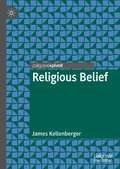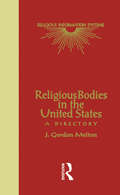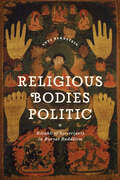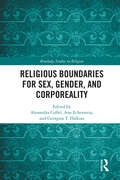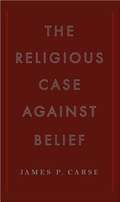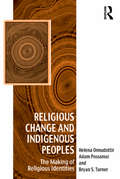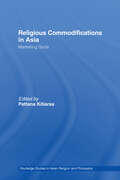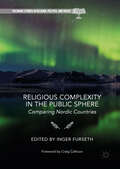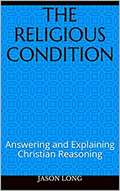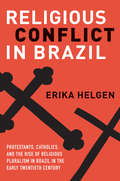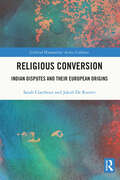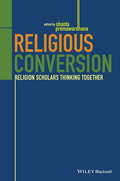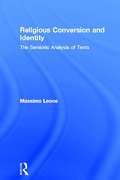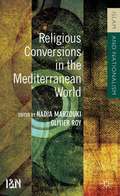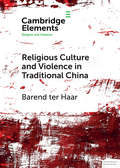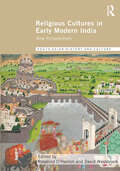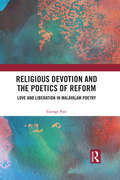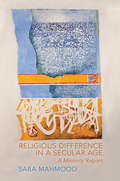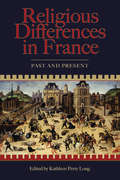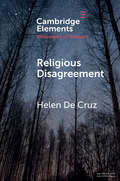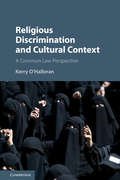- Table View
- List View
Religious Belief (Palgrave Frontiers in Philosophy of Religion)
by James KellenbergerThis book addresses the different forms that religious belief can take. Two primary forms are discussed: propositional or doctrinal belief, and belief in God. Religious belief in God, whose affective content is trust in God, it is seen, opens for believers a relationship to God defined by trust in God. The book addresses the issue of the relation between belief and faith, the issue of what Søren Kierkegaard called the subjectivity of faith, and the issue of the relation between religious belief and religious experience. After the introductory chapter the book continues with a chapter in which features and forms of belief allowed by the general concept of belief are presented. Several of these forms and features are related to the features of religious belief examined in succeeding chapters. The book's final chapter examines God-relationships in the Christian tradition that de-emphasize belief and are not defined by belief.
Religious Bodies in the U.S.: A Dictionary (Religious Information Systems)
by J. Gordon MeltonFirst Published in 1992. Routledge is an imprint of Taylor & Francis, an informa company.
Religious Bodies Politic: Rituals of Sovereignty in Buryat Buddhism (Buddhism and Modernity)
by Anya Bernstein"Religious Bodies Politic" examines the complex relationship between transnational religion and politics through the lens of one cosmopolitan community in Siberia: Buryats, who live in a semiautonomous republic within Russia with a large Buddhist population. Looking at religious transformation among Buryats across changing political economies, Anya Bernstein argues that under conditions of rapid social changeOCosuch as those that accompanied the Russian Revolution, the Cold War, and the fall of the Soviet UnionOCoBuryats have used Buddhist OC body politicsOCO to articulate their relationship not only with the Russian state, but also with the larger Buddhist world. aDuring these periods, Bernstein shows, certain people and their bodies became key sites through which Buryats conformed to and challenged Russian political rule. She presents particular cases of these emblematic bodiesOCodead bodies of famous monks, temporary bodies of reincarnated lamas, ascetic and celibate bodies of Buddhist monastics, and dismembered bodies of lay disciples given as imaginary gifts to spiritsOCoto investigate the specific ways in which religion and politics have intersected. Contributing to the growing literature on postsocialism and studies of sovereignty that focus on the body, "Religious Bodies Politic" is a fascinating illustration of how this community employed Buddhism to adapt to key moments of political change. "
Religious Boundaries for Sex, Gender, and Corporeality (Routledge Studies in Religion)
by Alexandra Cuffel Ana Echevarria Georgios T. HalkiasThe ambiguity concerning the interpretation of the ‘physical body’ in religious thought is not peculiar to any given religion, but is discernible in the scriptures, practices, and disciplines in most of the world’s major religious traditions. This book seeks to address the nuances of difference within and between religious traditions in the treatment and understanding of what constitutes the body as a carrier of religious meaning and/or vindication of doctrine. Bringing together an international team of contributors from different disciplines, this collection addresses the intersection of religion, gender, corporeality and/or sexuality in various Western and Eastern cultures. The book analyses instances when religious meaning is attributed to the human body’s physicality and its mechanics in contrast to imagined or metaphorical bodies. In other cases, it is shown that the body may function either as a vehicle or a hindrance for mystical knowledge. The chapters are arranged chronologically and across religious orientations, to offer a differentiated view on the body from a global perspective. This collection is an exciting exploration of religion and the human body. As such, it will be of great interest to scholars in religious studies, theology, Islamic studies, South Asian studies, history of religions and gender studies.
The Religious Case Against Belief
by James P. CarseAn insightful explanation for why belief-not religion-keeps us in a perilous state of willful ignorance Through careful , creative analysis, James P. Carse's The Religious Case Against Belief reveals a surprising truth: What is currently criticized as religion is, in fact, the territory of belief. Looking to both historical and contemporary crises, Carse distinguishes religion from belief systems and pinpoints how the closed-mindedness and hostility of belief has corrupted religion and spawned violence the world over. Drawing on the lessons of Galileo, Martin Luther, Abraham Lincoln, and Jesus Christ, Carse creates his own brand of parable and establishes a new vocabulary with which to study conflict in the modern world. Carse uses his wide-ranging understanding of religion to find a viable and vital path away from what he calls the Age of Faith II and toward open-ended global dialogue.
The Religious Case Against Belief
by Carse James P.An insightful explanation for why belief-not religion-keeps us in a perilous state of willful ignorance Through careful , creative analysis, James P. Carse's The Religious Case Against Belief reveals a surprising truth: What is currently criticized as religion is, in fact, the territory of belief. Looking to both historical and contemporary crises, Carse distinguishes religion from belief systems and pinpoints how the closed-mindedness and hostility of belief has corrupted religion and spawned violence the world over. Drawing on the lessons of Galileo, Martin Luther, Abraham Lincoln, and Jesus Christ, Carse creates his own brand of parable and establishes a new vocabulary with which to study conflict in the modern world. Carse uses his wide-ranging understanding of religion to find a viable and vital path away from what he calls the Age of Faith II and toward open-ended global dialogue. .
Religious Change and Indigenous Peoples: The Making of Religious Identities (Vitality of Indigenous Religions)
by Adam Possamai Helena OnnudottirExploring religious and spiritual changes which have been taking place among Indigenous populations in Australia and New Zealand, this book focuses on important changes in religious affiliation in census data over the last 15 years. Drawing on both local social and political debates, while contextualising the discussion in wider global debates about changing religious identities, especially the growth of Islam, the authors present a critical analysis of the persistent images and discourses on Aboriginal religions and spirituality. This book takes a comparative approach to other Indigenous and minority groups to explore contemporary changes in religious affiliation which have raised questions about resistance to modernity, challenges to the nation state and/or rejection of Christianity or Islam. Helena Onnudottir, Adam Posssamai and Bryan Turner offer a critical analysis to on-going public, political and sociological debates about religious conversion (especially to Islam) and changing religious affiliations (including an increase in the number of people who claim 'no religion') among Indigenous populations. This book also offers a major contribution to the growing debate about conversion to Islam among Australian Aborigines, Maoris and Pacific peoples.
Religious Commodifications in Asia: Marketing Gods
by Pattana KitiarsaThis book addresses the growing academic concerns of the market-religion convergences in Asia. Bringing together a group of leading scholars from Asia, Europe, Australia and North America, it discusses multiple issues regarding religious commodifications and their consequences across Asia’s diverse religious traditions. Covering key issues in the anthropology and sociology of contemporary Asian religion, it draws theoretical implications for the study of religions in the light of the shift of religious institutions from traditional religious beliefs to material prosperity. The fact that religions compete with each other in a ‘market of faiths’ is also at the core of the analysis. The contributions show how ordinary people and religious institutions in Asia adjusted to, and negotiated with, the penetrative forces of a global market economy into the region’s changing religio-cultural landscapes. An excellent contribution to the growing demands of ethnographically and theoretically updated interpretations of Asian religions, Religious Commodifications in Asia will be of interest to scholars of Asian religion and new religious movements.
Religious Complexity in the Public Sphere
by Inger FursethThis book is an empirical comparative study of the complexity of religion in the public spheres of the five Nordic countries. The result of a five-year collaborative research project, the work examines how increasingly religiously diverse Nordic societies regulate, debate, and negotiate religion in the state, the polity, the media, and civil society. The project finds that there are seemingly contradictory religious trends at different social levels: a growing secularization at the individual level, and a deprivatization of religion in politics, the media, and civil society. It offers a critique of the current theories of secularization and the return of religion, introducing religious complexity as an alternative concept to understand these paradoxes. This book is for scholars, students, and readers with an interest in understanding the public role of religion in the West.
The Religious Condition: Answering And Explaining Christian Reasoning
by Jason LongThe Bible is not the word of God. The Religious Condition is a broad look at the factors that drive Christians to believe otherwise. This part-philosophical, part-scientific overview explores the psychological and sociocultural influences that subtly provoke Christians to maintain their antiquated views of the universe. While billions of people around the world have merely assumed the solid validity of the Bible, The Religious Condition presents a series of profound questions regarding the implications of such premature assuredness. In addition to the conclusions from actual psychological studies that support these viewpoints, covered topics include the various ways that Christians approach scientific conflicts, the defense of a perfectly moral god who commits immoral acts, the illogical methods of argumentation that Christians invoke in the maintenance and defense of their beliefs, and disingenuous methods utilized by those who wish to defend the idea that religious beliefs are based on reason instead of faith. The Religious Condition answers actual reader responses to the previous works of Jason Long, a former Christian. His fresh experiences in the church and advanced levels of educational enlightenment make him the perfect individual to present this vehemently unpopular, yet undeniably appealing topic.
Religious Conflict in Brazil: Protestants, Catholics, and the Rise of Religious Pluralism in the Early Twentieth Century
by Erika HelgenThe story of how Brazilian Catholics and Protestants confronted one of the greatest shocks to the Latin American religious system in its 500-year history This innovative study explores the transition in Brazil from a hegemonically Catholic society to a religiously pluralistic society. With sensitivity, Erika Helgen shows that the rise of religious pluralism was fraught with conflict and violence, as Catholic bishops, priests, and friars organized intense campaigns against Protestantism. These episodes of religious violence were not isolated outbursts of reactionary rage, but rather formed part of a longer process through which religious groups articulated their vision for Brazil&’s national future.
Religious Conversion: Indian Disputes and Their European Origins (Critical Humanities Across Cultures)
by Sarah Claerhout Jakob De RooverThis book re-examines the issue of religious conversion, which has been a site of conflict in India for several centuries. It discusses wide-ranging themes such as conversion, education, and reform in colonial India; the process and practices of conversion in Christian Europe; Gandhi, conversion, and the equality of religions; perspectives from Hindu nationalism, secularism and religious minorities; religious freedom and the limits of propagating religion; and conversion in constitutional law, commissions, and courts, to chart new directions for research on religion, tradition, and conversion. Tracing developments from the 19th-century colonial era to contemporary times, the book analyses cultural background frameworks and the origins of religious conversion and its conceptualisation in Western Christianity. It further delves into how Indian culture and its traditions have shaped responses to conversion. Part of the Critical Humanities Across Cultures series, this book will be useful to scholars and researchers of critical humanities, religion, cultural studies, sociology of religion, comparative religion, philosophy, anthropology, theology, Indology, history, politics, postcolonial studies, critical theory, and South Asian studies.
Religious Conversion: Religion Scholars Thinking Together
by Shanta PremawardhanaReligious Conversion: Religion Scholars Thinking Together explores various issues relating to the nature, methods, and effects of religious conversion in the major world faiths. Presents the results of an innovative ten-year project initiated the World Council of Churches Features contributions from religious scholars and leaders of Buddhist, Christian, Hindu, Jewish, and Muslim traditions Considers myriad issues relating to the nature, methods, and effects of religious conversion in the major world faiths Addresses questions on religious freedom, legal considerations, and the future for religious conversion
Religious Conversion and Disaffiliation
by Henri GoorenThis book is the first in over a decade to attempt a systematic synthesis of the field of conversion studies, encompassing the disciplines of anthropology, sociology, psychology, history, and theology. Gooren analyzes conversion and disaffiliation in a worldwide comparative framework, using data from North America, Europe, and Latin America.
Religious Conversion and Identity: The Semiotic Analysis of Texts (Routledge Studies in Religion #Vol. 3)
by Massimo LeoneThe way in which people change and represent their spiritual evolution is often determined by recurrent language structures. Through the analysis of ancient and modern stories and their words and images, this book describes the nature of conversion through explorations of the encounter with the religious message, the discomfort of spiritual uncertainty, the loss of personal and social identity, the anxiety of destabilization, the reconstitution of the self and the discovery of a new language of the soul.
Religious Conversions in the Mediterranean World
by Nadia Marzouki Olivier RoyWhile globalization undermines ideas of the nation-state in the Mediterranean, conversions reveal how religion can unsettle existing political and social relations. Through studies of conversions across the region this book examines the challenges that conversions represent for national, legal and policy ways of dealing with religious minorities.
Religious Culture and Violence in Traditional China (Elements in Religion and Violence)
by Barend ter HaarThe basis of Chinese religious culture, and with that many aspects of daily life, was the threat and fear of demonic attacks. These were inherently violent and could only be counteracted by violence as well - even if this reactive violence was masked by euphemisms such as execution, expulsion, exorcisms and so on. At the same time, violence was a crucial dimension of the maintenance of norms and values, for instance in sworn agreements or in beliefs about underworld punishment. Violence was also an essential aspect of expressing respect through sacrificial gifts of meat (and in an earlier stage of Chinese culture also human flesh) and through a culture of auto-mutilation and ritual suicide. At the same time, conventional indigenous terms for violence such as bao 暴 were not used for most of these practices since they were not experienced as such, but rather justified as positive uses of physical force.
Religious Cultures in Early Modern India: New Perspectives (Routledge South Asian History and Culture Series)
by Rosalind O’Hanlon and David WashbrookReligious authority and political power have existed in complex relationships throughout India’s history. The centuries of the ‘early modern’ in South Asia saw particularly dynamic developments in this relationship. Regional as well as imperial states of the period expanded their religious patronage, while new sectarian centres of doctrinal and spiritual authority emerged beyond the confines of the state. Royal and merchant patronage stimulated the growth of new classes of mobile intellectuals deeply committed to the reappraisal of many aspects of religious law and doctrine. Supra-regional institutions and networks of many other kinds - sect-based religious maths, pilgrimage centres and their guardians, sants and sufi orders - flourished, offering greater mobility to wider communities of the pious. This was also a period of growing vigour in the development of vernacular religious literatures of different kinds, and often of new genres blending elements of older devotional, juridical and historical literatures. Oral and manuscript literatures too gained more rapid circulation, although the meaning and canonical status of texts frequently changed as they circulated more widely and reached larger lay audiences.Through explorations of these developments, the essays in this collection make a distinctive contribution to a critical formative period in the making of India’s modern religious cultures.This book was published as a special issue of South Asian History and Culture.
Religious Deviance in the Roman World: Superstition or Individuality?
by Jörg RüpkeReligious individuality is not restricted to modernity. This book offers a new reading of the ancient sources in order to find indications for the spectrum of religious practices and intensified forms of such practices only occasionally denounced as 'superstition'. Authors from Cicero in the first century BC to the law codes of the fourth century AD share the assumption that authentic and binding communication between individuals and gods is possible and widespread, even if problematic in the case of divination or the confrontation with images of the divine. A change in practices and assumptions throughout the imperial period becomes visible. It might be characterised as 'individualisation' and informed the Roman law of religions. The basic constellation - to give freedom of religion and to regulate religion at the same time - resonates even into modern bodies of law and is important for juridical conflicts today. Written by one of the most important scholars working on Roman religion today. Reconstructs a hitherto neglected feature of ancient Mediterranean religion and its conceptualisation by contemporaries. Offers an important insight into both public religious norms and the primacy of individual religious experience in the ancient world.
Religious Devotion and the Poetics of Reform: Love and Liberation in Malayalam Poetry
by George PatiThe poetry emanating from the bhakti tradition of devotional love in India has been both a religious expression and a form of resistance to hierarchies of caste, gender, and colonialism. Some scholars have read this art form through the lens of resistance and reform, but others have responded that imposing an interpretive framework on these poems fails to appreciate their authentic expressions of devotion. This book argues that these declarations of love and piety can simultaneously represent efforts towards emancipation at the spiritual, political, and social level. This book, through a close study of Naḷini (1911), a Malayalam lyric poem, as well as other poems, authored by Mahākavi Kumāran Āśān (1873–1924), a low-caste Kerala poet, demonstrates how Āśān employed a theme of love among humans during the modern period in Kerala that was grounded in the native South Indian bhakti understanding of love of the deity. Āśān believed that personal religious freedom comes from devotion to the deity, and that love for humans must emanate from love of the deity. In showing how devotional religious expression also served as a resistance movement, this study provides new perspective on an understudied area of the colonial period. Bringing to light an under-explored medium, in both religious and artistic terms, this book will be of great interest to scholars of religious studies, Hindu studies, and religion and literature, as well as academics with an interest in Indian culture.
Religious Difference in a Secular Age
by Saba MahmoodThe plight of religious minorities in the Middle East is often attributed to the failure of secularism to take root in the region. Religious Difference in a Secular Age challenges this assessment by examining four cornerstones of secularism--political and civil equality, minority rights, religious freedom, and the legal separation of private and public domains.Drawing on her extensive fieldwork in Egypt with Coptic Orthodox Christians and Bahais--religious minorities in a predominantly Muslim country--Saba Mahmood shows how modern secular governance has exacerbated religious tensions and inequalities rather than reduced them. Tracing the historical career of secular legal concepts in the colonial and postcolonial Middle East, she explores how contradictions at the very heart of political secularism have aggravated and amplified existing forms of Islamic hierarchy, bringing minority relations in Egypt to a new historical impasse. Through a close examination of Egyptian court cases and constitutional debates about minority rights, conflicts around family law, and controversies over freedom of expression, Mahmood invites us to reflect on the entwined histories of secularism in the Middle East and Europe.A provocative work of scholarship, Religious Difference in a Secular Age challenges us to rethink the promise and limits of the secular ideal of religious equality.
Religious Differences in France: Past and Present (Sixteenth Century Essays & Studies #74)
by Kathleen Perry LongThis volume examines the history of religious dissent and discord in France from the time of the Wars of Religion to the present day. Contributors analyze the various solutions elaborated by the government, by religious institutions, and by private groups in response to the serious problems raised by religious differences. This collection of essays also explores the impact these problems and solutions have on religious and national identity, and how these issues play out in political and religious life today.
Religious Differences in France: Past and Present (Sixteenth Century Essays & Studies #74)
by Kathleen Perry LongThis volume examines the history of religious dissent and discord in France from the time of the Wars of Religion to the present day. Contributors analyze the various solutions elaborated by the government, by religious institutions, and by private groups in response to the serious problems raised by religious differences. This collection of essays also explores the impact these problems and solutions have on religious and national identity, and how these issues play out in political and religious life today.
Religious Disagreement (Elements in the Philosophy of Religion)
by Helen De CruzThis Element examines what we can learn from religious disagreement, focusing on disagreement with possible selves and former selves, the epistemic significance of religious agreement, the problem of disagreements between religious experts, and the significance of philosophy of religion. Helen De Cruz shows how religious beliefs of others constitute significant higher-order evidence. At the same time, she advises that we should not necessarily become agnostic about all religious matters, because our cognitive background colors the way we evaluate evidence. This allows us to maintain religious beliefs in many cases, while nevertheless taking the religious beliefs of others seriously.
Religious Discrimination and Cultural Context: A Common Law Perspective
by Kerry O'HalloranGenerations of festering culture wars, compounded by actual wars in predominantly Muslim countries, the terrorism of Isis, and the ongoing migrant crisis have all combined to make religious discrimination the most pressing challenge now facing many governments. For the leading common law nations, with their shared Christian cultural heritage balanced by a growing secularism, the threat presented by this toxic mix has the potential to destabilise civil society. This book suggests that the instances of religious discrimination, as currently legally defined, are constrained by that cultural context, exacerbated by a policy of multiculturalism, and in practice, conflated with racial, ethnic or other forms of discrimination. Kerry O'Halloran argues that many culture war issues - such as those that surround the pro-choice/pro-life debate and the rights of the LGBT community - can be viewed as rooted in the same Christian morality that underpins the law relating to religious discrimination. Suggests that present forms of religious discrimination are shaped by past cultural traditions. Demonstrates how many culture war issues - such as abortion and gay marriage - are forms of religious discrimination. Provides a comparative analysis of religious discrimination case law which shows how judicial treatment of matters such as accommodating religious belief in the workplace varies on a jurisdictional basis.
